Let's say you buy a brand-new Lexus. You take it for a spin and decide to turn the radio on to check out the sound system. It's pretty decent, and you like your car that much more. Months down the road, you're messing around with the console and you feel your chair start to warm up - your car has heaters in each seat! “Nice,” you think. “I wish I'd found this sooner.”
That's exactly how your users feel when they discover game-changing features they never realized existed before, and it's your responsibility to ensure finding them is not left up to chance.
Feature adoption enables users to get more value from your product by getting beyond the core usage as they advance through your product.
In this article, you'll learn about getting a higher number of users engaged with more than your core product features. We'll also look at ensuring they keep using them, and how you can measure the success of your advanced feature adoption efforts long-term.
TL;DR
Feature adoption refers to how users discover your product's functionality
Advanced feature adoption focuses on familiarizing users with your more complex features, developing a habit of using them, and getting to the full potential of your product
The feature adoption funnel includes four steps: Exposed, Activated, Used, and Used again
You can measure feature adoption by tracking your adoption rate, time-to-first key action, and average time spent using the feature
The best ways to increase advanced feature adoption is by personalized onboarding flows, contextual in-app guidance, and in-product prompts that help users immediately understand the benefits
Okay so what exactly is feature adoption?
Put simply, feature adoption is how your users discover and use the features available to them within your product. It's a process all users undergo when getting to grips with a new product.
The SaaS subscription-based pricing model has made feature adoption an essential consideration for businesses. Why? Because the fewer features your users use, the less value they perceive your product to provide.
Let me ask you this - which sounds better to you: paying $199/month for three features you know and love or paying $199/month for ten features you will actually use?
Feature adoption enables users to get more value from your product by getting beyond the core usage as they advance through your product.
What is the importance of feature adoption?
Feature adoption when done right does a lot of good for your business. Of course you wanna have a clear ROI on the KPIs of doing this right. The good news is that a high feature adoption rate directly corresponds to a higher product adoption rates, high customer lifetime value, low retention and how actively users interact with your product. Here's a rundown:
High feature adoption = High user satisfaction
This one is obvious - high user satisfaction is directly tied to a high feature adoption rate. The more value your users get out of your product, the more satisfied your customers are, and the higher the customer lifetime value becomes. Your goal with feature adoption isn't to bombard users and overwhelm them with their workflows but rather introduce key features at the right time, within the right context.
High feature adoption rate = high user retention
User retention is the lifeblood of any business, and churn is the silent killer. No matter how many users you acquire or how high your revenue is, if your customer satisfaction is low, your users will churn (almost inevitably). The good news is that feature adoption goes a long way to reduce churn for your users. When users use your features consistently, in a habit-forming way, and derive continuous value out of it, your feature adoption metrics go high. And as a result, your churn inevitably drops. On the flip side, if users aren't using your features, then it may be a sign that there are some fundamental issues that need fixing.
High feature adoption rate = high perceived value
Perceived value is more subtle but goes a long way to form preconceived notions about your product and its core offerings. What you want here is to make sure that your users not only perform key actions but also use features that augment or complement their existing workflow, so they can derive even more value out of your product. Let's face it - subscription fatigue is a real thing. So if your users find that they are getting more bang out of their buck, they stick around for longer because the perceived value of your product goes up in their eyes.
How is feature adoption different from product adoption?
Now I know what you're thinking - isn't feature adoption & product adoption kind of the same thing? Well, not quite. If product adoption is the parent, then feature adoption is the child.
Product adoption applies to your whole product - your revenue, your retention, your churn, your activation rates, all the cool fun things we talk about at Chameleon a lot.
Feature adoption is more granular since it applies to just that one feature you're focusing on - how strong is the feature usage frequency? Is user engagement low for this feature? Are users adopting the feature enough or are they churning?
These questions help you get to the heart of understand how your users engage with your features consistently and as a result, how much value are they getting on an ongoing basis.
As you can see, this is pretty important!
What is advanced feature adoption?
Now, there are levels of complexity when it comes to feature adoption. Your users will likely start using your core features from the get-go, but it's the advanced features you want to focus on promoting.
Advanced feature adoption focuses on getting your users comfortable with the features that don't often take the limelight but can still be greatly beneficial to users. Especially if they know where to find them and how to use them....
Both new features and existing features often remain undiscovered - especially those that aren't included in your core feature offerings. These are typically advanced features, very useful for their intended application, but not as apparent to users at first glance.
It's time to shine a light on your advanced features and how they add value to your user's experience with your product.
Which brings us to the adoption metrics to track...
How to track feature adoption through the funnel
Just like with many concepts in the SaaS world, feature adoption has a funnel. That funnel can be applied to advanced feature adoption, too.
The feature adoption funnel was developed by Justin Butlion, Founder of ProjectBI, to effectively track the adoption rates.
The funnel includes four steps:
Exposed: This looks at the number of users who have seen the feature or are aware of its existence
Activated: This one's only applicable if the feature in question requires activation—they often don't need an activation point. If that's the case, skip this step.
Used: This is the number of users that have used the feature once.
Used again: You guessed it - this is the number of users who go on to use the feature again.
This might seem like a four-step funnel, but it's really not. Once you're at the “used again” step, you want to keep asking the question of usage over and over again. View the question not as “Did they use the feature again?”, but more as “Did they use the feature again since the last time?”.
Getting users to engage with a feature twice isn't a job done. You need to continue checking months down the line for an accurate understanding of feature adoption, especially when it comes to advanced features.
Advanced features aren't as sticky as core ones, which is a feature adoption lingo for “they're less likely to get regular usage”. This is due to a number of reasons:
Advanced features don't get as much exposure - think out of sight, out of mind
They can be trickier to get to grips with - pushing users to give up
They can have pretty niche uses - some users may not instantly see their value
Luckily for you, we've got a whole section on overcoming these hurdles further down. For now, let's turn our focus back to the funnel and why it's useful.
The feature adoption funnel enables you to gain insights on feature adoption that can help with prioritizing features when it comes to exposure, onboarding, and more.
James Butlion shares this example of how to use the funnel for a time frame of new (feature) users acquired in one month.

(Source)
By calculating the number of users that pass through the four stages of the funnel, you can identify issues with the process and better understand the user journey.
In the example above, we can see a massive drop-off from feature activation to first use. This could point toward the feature being too difficult to use - meaning you might want to revisit the feature onboarding process.
Tracking feature adoption is insightful for product managers and teams but can often lead to more questions. If it answers what you're after, you'll want to consider how to measure feature adoption.
3 key metrics to measure feature adoption
There are lots of feature adoption metrics and, here, we'll focus on the top three.
1. Feature adoption rate
You can measure feature adoption with the same formula you use for product adoption, only adjusted to consider feature users.

What constitutes a user of a feature really depends on the feature in question. Is it someone who's clicked on the feature? Is it someone who's performed a key action in the feature? Is it someone who's used it more than once?
Feature adoption looks different in every product, but this formula is a go-to for calculating it in yours.
2. Time-to-first key action
This is a key metric when looking at feature adoption, as it indicates how quickly users can perform the key action. The key action is a step taken within a feature that signifies that the user has discovered how to use it.
A slow time-to-first-action likely signifies an issue with your feature onboarding or functionality. Ideally, you want users' time-to-value to be as short as possible.
To iterate on this, you could create feature-specific Tours with Chameleon, and leverage the bi-directional integrations between Chameleon and product analytics tools like Heap, Mixpanel, or Amplitude, to group the tour performance data and understand user behavior on a deeper level.
This could help you tie your Tour performance data to your key activation milestones, and perform a cohort analysis to then compare the behavior of those who successfully completed the first key actions to those who haven't, depending on how many steps they've previously completed.
It would then be easy to look at the performance data and identify underperforming feature onboarding flows you want to focus on and improve. Here's an example of what you could see in a Chamaleon Dashboard.
3. Average time spent using the feature
This one's pretty self-explanatory, you want to measure the amount of time users spend on the feature in question. This can provide really useful insights into change management and feature adoption.
For example, if you measure time spent using the feature for users who failed to complete the key action—you can see how long it takes users to give up trying. This can then help you improve the feature and its functionality to help ensure adoption is speedy.
4. Depth of Feature Adoption
Depth of feature adoption = how often do key user segments use a said feature? What do they use it for? Is it a non-negotiable for them? What will happen if they stop using it?
A high depth of feature adoption directly corresponds to your feature’s stickiness, relevance, and usefulness. Here's the formula for calculating depth of feature adoption:
Depth of adoption = (number of users) × (frequency of use) × (intensity of use) × (breadth of features used)
5. User Retention Rate
By looking at data around your users' feature adoption metrics, you can compare the behavior of returning users’ across different user segments over time. You can do a cohort analysis here to get really granular and find out which cohort of users use X feature the most and over what time span. How much is the average time to adopt the said feature? This will give you data on where users are dropping off, and why they're dropping off, helping you retain your users before they actually churn.
6. Drop-off Rate
A high drop-off rate with respect to a specific feature often means one thing - there is a misalignment of user expectations and the feature's actual functionality. It is a tell-tale sign that your PMF isn't quite PMFing. If your drop off rates are low, it means that you have created a smooth, intuitive user experience flow that gets them to the AHA moment where they are able to realise the value of the said feature in a short time span. The lower your time to adopt, the highee your chances are of nailing product market fit.
For the best results, combine user adoption and user retention rates
Remember what we said earlier about the four-step funnel that's not really a four-step funnel? We're revisiting it here.
To keep answering the “used again” question, you want to combine user adoption and user retention rates. Measuring both adoption and retention gives you deeper insights by enabling you to measure how many new users are still using the feature weeks, months, or even years down the line.
Plus, it's not just us saying it. Google's HEART framework highlights the importance of measuring these two metrics in unison. HEART stands for Happiness, Engagement, Adoption, Retention, and Task success, and Google has developed it for tracking user-centered metrics in web apps.
Google specifically advises combining adoption and retention metrics “to provide stronger insight into counts of the number of unique users in a given period, addressing the problem of distinguishing new users from existing users.”
How to increase the adoption rate for your advanced features / How to improve feature adoption rates
It's all well and good telling you how important advanced feature adoption is for product success, but what use would it be if we didn't tell you how. Here are some of our top guidelines on how to engage users with advanced features.
Use in-app messaging to grab your user's attention
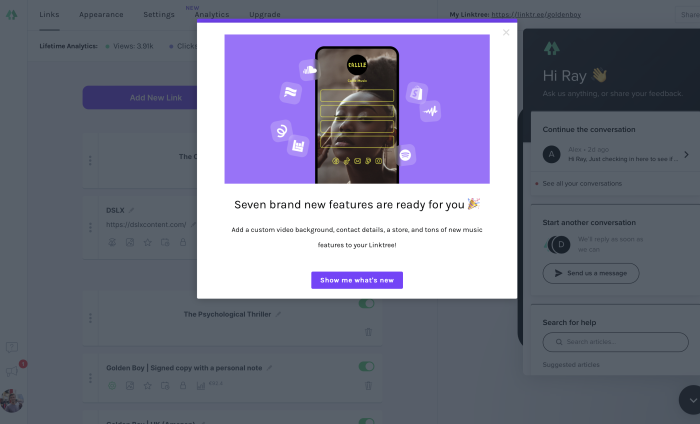
(Source)
In-app messages are delivered to your users while they're using your product. These could be in form of tooltips, checklists, product tours, slide-outs, modals, banners, or other in-product widgets.
These in-product widgets give users contextual information on your product and how they can use it, as we see in the above example from Linktree - announcing seven new features in-app with a clear and concise modal.
In-app messaging can be used to encourage users to engage with the advanced features they've not yet taken a closer look at. It not only enables you to highlight the new feature but also guides users on how to use it via tours, walkthroughs, and tooltips.
You can deploy in-app notifications at any time during the onboarding experience, which starts when the user signs up for your product and ends, well… never.
Tailor feature onboarding flows to specific user segments
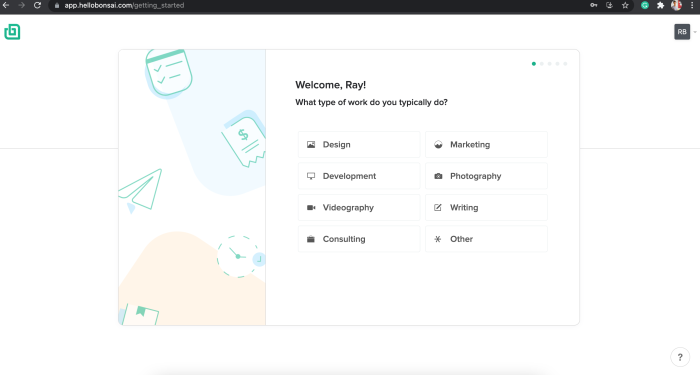
(Source)
A strong onboarding flow is an essential part of your product and brand. It's the helping hand you guide users with to get them accustomed to your software.
Onboarding experiences are often created with a one-size-fits-all approach—but the best onboarding flows are personalized, created with specific users in mind.
Segmenting your user base for the onboarding to advanced features enables you to provide an experience that's unique to their wants and needs.
This way, you can walk users through the relevant features they're most likely to enjoy (and use) in your product. This also includes your features that may not make the cut when creating one single onboarding flow for all users.
For example, let's say your product provides project management software to be used across an organization. The finance team will use it differently from the marketing team, who'll use it differently from the product team, and so on.
A segmented onboarding flow uses the information your users have provided during sign-up or their first steps in your product, such as the user's role within their organization, to highlight features based on the user in question. Using our example, the finance team could be shown advanced features relating to invoicing and data visualization.
In other words, segmented onboarding facilitates feature discovery from the get-go.
Gather feedback from users on the feature experience
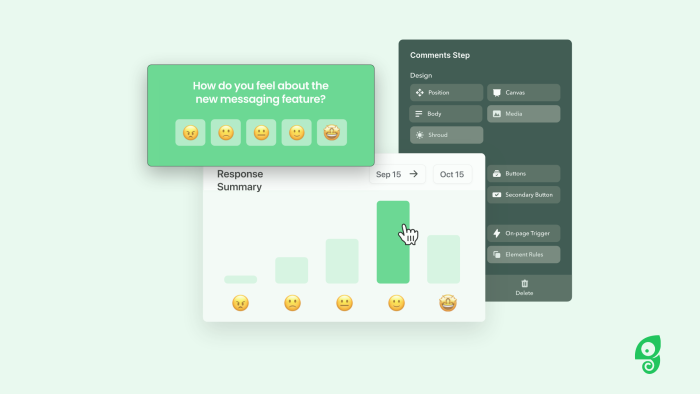
Our final tip is to continually collect user feedback to optimize the feature adoption experience. This enables you to learn from your users and create a better product experience that guides more users to your advanced features.
For this purpose, you can use Microsurveys and easily configure them for each specific case. In the example above, you see a summary of what configuration, design, and response data could look like for a survey created with Chameleon.
You want to gather contextual user feedback on the advanced feature onboarding process to ensure you reach users when the experience is fresh. Microsurveys enable you to collect feedback from users as they're engaging with your product.
For example, as shown above, you could create a survey that appears in relation to a new or updated messaging feature. With a single question “How do you feel about this feature”, you could collect invaluable feedback on the spot and integrate insights into further improvements and developments.
Build features that solve user problems
Use in-app guidance to provide contextual feature training to users
Collect and analyze user behavior data to understand how new features are being used and adopted
Use user data and feedback to experiment and test (and then repeat).
Tools to help you improve feature adoption rate
1. Feature release announcements
One of the best way to showcase new feature releases is with the evergreen feature release announcements. You can trigger an in-app modal using a DAP like Chameleon and show them to your users, or you can trigger them across multiple channels - email, social media, website/landing pages are all fair game. And if it's a game-changing feature, then you can go the extra mile and even run ads for your feature to get people to interact with it.
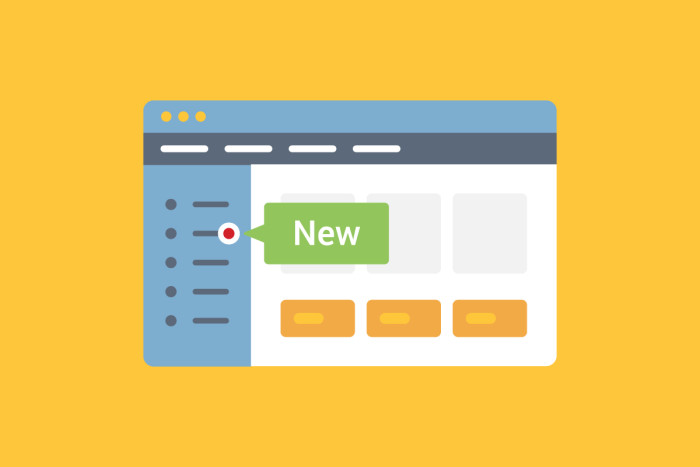
2. In-app messaging
This one is pretty self-explanatory. In-app messaging is one of the best ways to showcase new features to user and boost feature adoption rate. Why? Because it's almost always shown in context. Based on how users interact with your product, you can trigger in-app messages that show off your new feature that complements or augments the features they are already familiar with. At which stage, it turns into a wow factor for your users and they go "Woah i cant wait to try it out!". And in case you're wondering, yes, you can create these in-app messages with Chameleon.
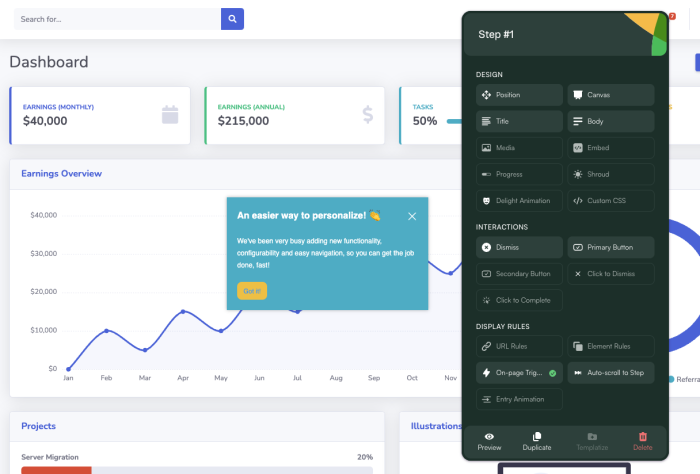
3. Release notes
Release notes are another great way to announce to users that new features are now live on your product! The cool thing about release notes is that users can see just how many new features you've shipped for them (making them appreciate you more!) and reinforces that wow factor. Not to mention, it shows them how consistent you are with your feature updates making them feel like they're getting increasing value out of your product (without paying extra).

4. Step-by-step, interactive feature walkthroughs
If you have a feature that has a slight learning curve, you can't go wrong with an engaging, interactive (but short) feature walkthrough! When you have a feature that's high-impact & high-value, you want to make sure your feature adoption rate is as high as possible. One of the best ways to do that is to make users feel like they're actually using the feature before they commit to actually using the feature.

5. Task lists
Task lists is how Trello became a billion dollar company. They're deceptively simple yet incredibly powerful when done right. With task lists, you can generate a list of helpful steps for users to complete relevant to your feature. It's the perfect way to subtly introduce users to your new feature without overwhelming them.
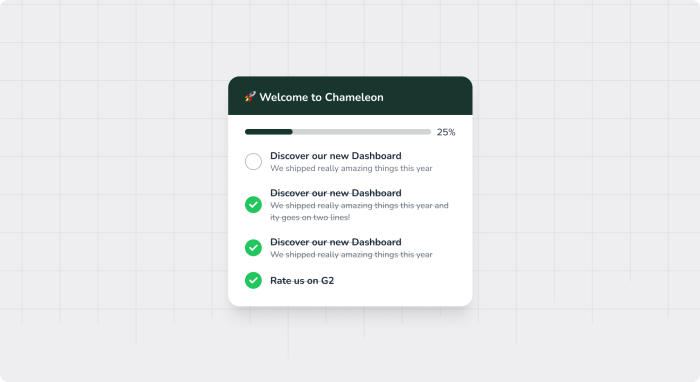
6. Hotspots and tooltips
Hotspots are great to draws your user’s attention to your feature. While they're busy using your product, hotspots highlight features constantly so the user is always aware that this is something worth checking out (so that he can get more value). Same deal with tooltips but they're more subtle. When your user clicks or hovers on it, it will display an extra text area which you can use to give more context about your feature and what they can use it for.
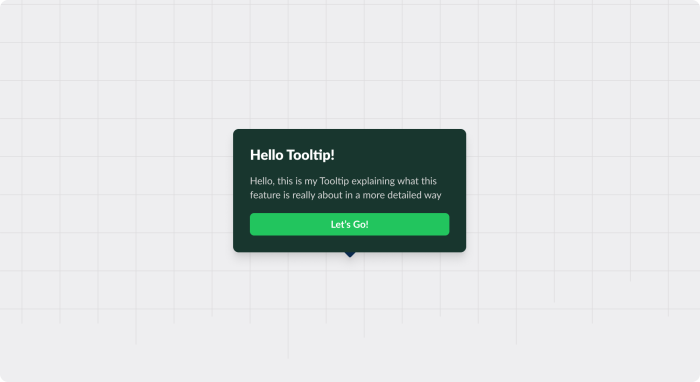
7. Banners and pop-ups
Lastly, you got your banners and pop-ups - two very popular onboarding components to drive feature adoption. You can use pop-up modals to highlight new or existing features users would want to engage with. And with banners, you can embed them at the top of your product dashboard, where they can capture a user’s attention so you can share more details about your feature without it being too intrusive.
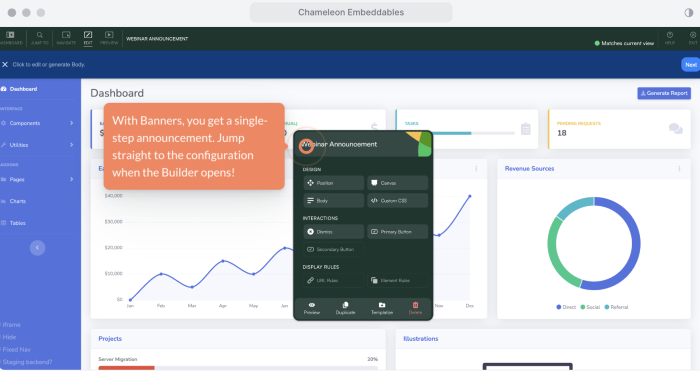
8. Increase advanced feature adoption to nurture power users
You've done the hard part - putting time and effort into building a powerful product. Now it's time to make sure your customers know how to use it to its full potential.
Improvements to your advanced feature onboarding process ensure your users are able to discover the features that are most valuable to them. It's also a great opportunity to turn your active users into power users by highlighting product and feature value.
Conclusion
Getting users to try a feature is good. Getting them to come back to it? That’s where the magic happens.
Advanced feature adoption isn’t about throwing more functionality at your users - it’s about guiding them to value, again and again. From the moment they’re exposed to a feature, through activation, usage, and return engagement, every step of the adoption funnel matters.
Measure what counts: time-to-first-action, repeat usage, and how long it takes for a user to say “oh, I get it now.”
And don’t leave adoption to chance. Layer in personalized onboarding, contextual nudges, and in-app prompts that show, not tell, why your advanced features matter.
Because the deeper users go, the more they stick.
